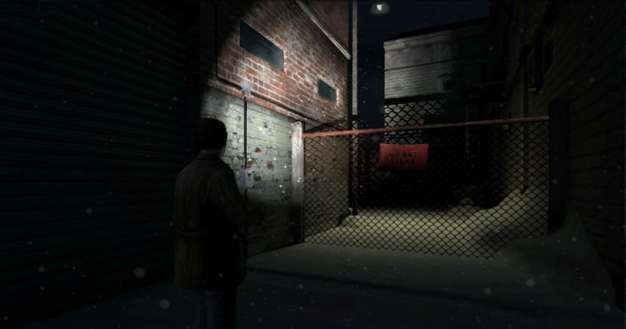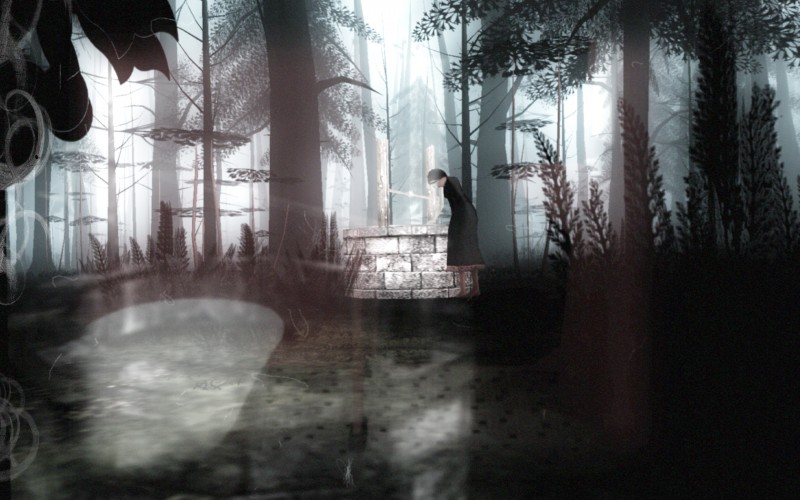This week marks the release of one of the strangest games to come out of a major studio in quite a long time: Konami’s and Climax Studio’s Silent Hill: Shattered Memories. It is memorable for a variety of reasons, but ithe game’s most unique design choice sees gameplay limited to analyzing environments for the vast majority of it. There’s no combat, seldom few puzzles, and exploration is kept to a minimum with little room to stray from the beaten path. Instead, the gameplay mostly lies in searching around you for clues as you try to piece together the game’s tragic and mysterious tale. In this sense, Silent Hill: Shattered Memories is more of an extended interactive cutscene at times, a concept I once scoffed at.
My feeling was that if a game aims to tell a linear tale with no win or lose condition, what’s the point of it being a game in the first place? Action games reward dexterity and skill, whereas puzzle games reward keen intellect. If games don’t tease my mind in such ways and want only to tell a story, they can be handled best as movies – at least that’s what I thought.
It’s a design philosophy that can be found in even the most story driven games like BioShock and Half-Life 2. It’s not enough that those games tell a story, they have to let you shoot stuff too, lest people complain that they’re not gamey enough.
The new Silent Hill does away with conventional notions of what it means to be a game. To its credit, I found the simple act of trying to comprise what the hell was going on to be as thoughtful and engaging as any game I’ve played this year.

Shattered Memories makes the player observe its environments to great effect.
I do have a confession to make, though. While I’d always been intrigued by the Silent Hill series, I’d never found it games much fun to play. I’d enjoy the aesthetics, rich metaphors and lucid atmosphere, but always found the experience of playing them something of a chore. They relied far too much on fetch quests, obtuse puzzles, lackluster combat, and stressful resource management.
In comparison, Shattered Memories dissipates all of these. What’s left may be slim to some, given that it’s only about seven hours long and without much room to stray from its rigid path. Instead, it boils down to the core of what made the Silent Hill series so compelling initially.
By the game being stripped down to its essence, I found it an altogether stronger experience. It took all the things I’d loved about the Silent Hill games and shed all that I didn’t. The game isn’t particularly difficult, with little more than a handful of escape sequences that are also the only times you can even get a game over. However, the real challenge doesn’t stem from making it through the game, but from making sense of its metaphors. Things like combat and puzzle-solving have become staples of how to challenge a player in a video game. Fun though they may be, in a plot driven experience these types of challenges come off as false ways to impede progress. For example, as much as I was fascinated by Silent Hill 3’s story, it was easy to hit a difficulty spike or run out of healing resources, making it difficult to see it through to its end. I’m not saying that should be done away with completely as there are players out there who love slow, tense slogs through hellish underworlds full of monsters, but I no longer feel that’s a necessity to making a solid horror game.
Shattered Memories reminds me of another game comprised almost entirely of collecting things to flesh out a tragic story: The Path. That game cast you as a series of Little Red Riding Hood incarnates, asking you to stray from the titular path and explore the surrounding woods which were comprised of objects connected to each girl’s memories. Finding these memories fleshes out each girl’s tragic story as her encounter with her own metaphorical wolf. The Path’s gothic art direction, lack of loss condition, and focus on open-ended metaphors intrigued me greatly. However, it was made by a small handful of people. Artistry and risks are almost taken for granted with low budgets and small teams. For a major studio like Konami to take such a big risk with an established franchise is practically unheard of. It’d be like the next Halo is a point-and-click adventure – okay, not quite, but you get the idea.

The Path’s unusual design made it one of 2009’s most distinctive video games.
Simply piecing metaphors together and scrutinizing a piece of art for meaning is the kind of interaction we’ve been doing since time immemorial. The difference is that in a game it’s up to you to find all the red herrings by interacting with the environment. And by ‘interacting’, I don’t mean manipulating or collecting items (though there is a bit of that too), but rather through the simple act of exploring and observing. In other media, you’re spoonfed information and then it’s up to the reader or viewer regards how much they wish to interpret that information. In a game, you have to work a little to find the clues. Observation, in and of itself, is a form of play, one that is often taken for granted in a goal obsessed industry.
While I’ve certainly enjoyed slaughtering demons and solving puzzles in video games, the medium can often provide more with less. While elements like these are fun, I don’t feel like they’re necessary for a game to be fun. Games can be engaging by simply letting you explore an intriguing scenario at your own pace, all without worry of getting a game over or having to conquer some obscure puzzle to progress. Climax Studios knows this and their guided, minimalist approach to game design is something I hope inspires other developers to take risks with their established formulas.
”